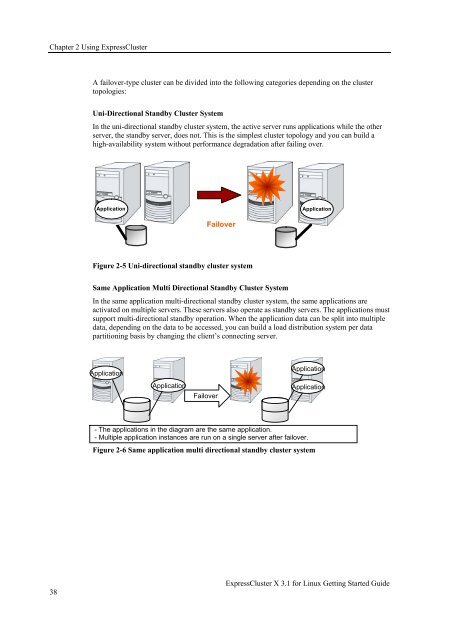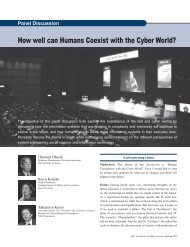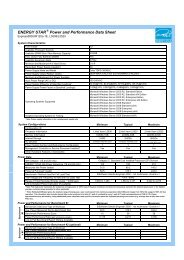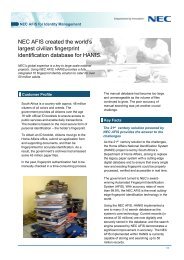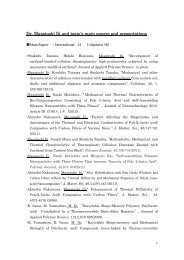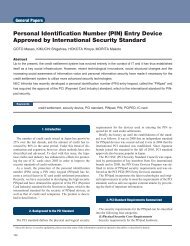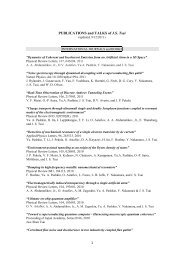- Page 1 and 2: ExpressCluster ® X 3.1 for LinuxGe
- Page 3: © Copyright NEC Corporation 2011.
- Page 6 and 7: Section II Installing ExpressCluste
- Page 8 and 9: Shutdown and reboot of individual s
- Page 10 and 11: ExpressCluster X Documentation SetT
- Page 12 and 13: Contacting NECFor the latest produc
- Page 15 and 16: Chapter 1What is a cluster system?T
- Page 17 and 18: High Availability (HA) clusterShare
- Page 19: High Availability (HA) clusterData
- Page 22 and 23: Chapter 1 What is a cluster system?
- Page 24 and 25: Chapter 1 What is a cluster system?
- Page 26 and 27: Chapter 1 What is a cluster system?
- Page 29 and 30: Chapter 2Using ExpressClusterThis c
- Page 31 and 32: Software configuration of ExpressCl
- Page 33 and 34: Software configuration of ExpressCl
- Page 35 and 36: Network partition resolutionNetwork
- Page 37: Failover mechanismFailover resource
- Page 41 and 42: Failover mechanismHardware configur
- Page 43 and 44: Failover mechanismWhat is cluster o
- Page 45 and 46: What is a resource?NAS resource (na
- Page 47 and 48: What is a resource?Websphere monito
- Page 49: Section IIInstallingExpressClusterT
- Page 52 and 53: Chapter 3 Installation requirements
- Page 54 and 55: Chapter 3 Installation requirements
- Page 56 and 57: Chapter 3 Installation requirements
- Page 58 and 59: Chapter 3 Installation requirements
- Page 60 and 61: Chapter 3 Installation requirements
- Page 62 and 63: Chapter 3 Installation requirements
- Page 64 and 65: Chapter 3 Installation requirements
- Page 66 and 67: Chapter 3 Installation requirements
- Page 68 and 69: Chapter 3 Installation requirements
- Page 70 and 71: Chapter 3 Installation requirements
- Page 72 and 73: Chapter 3 Installation requirements
- Page 74 and 75: Chapter 3 Installation requirements
- Page 76 and 77: Chapter 3 Installation requirements
- Page 79 and 80: Chapter 4Latest version information
- Page 81 and 82: System requirements for WebManager
- Page 83 and 84: System requirements for WebManager
- Page 85 and 86: System requirements for WebManager
- Page 87 and 88: System requirements for WebManager
- Page 89 and 90:
System requirements for WebManager
- Page 91 and 92:
System requirements for WebManager
- Page 93 and 94:
System requirements for WebManager
- Page 95 and 96:
System requirements for WebManager
- Page 97 and 98:
System requirements for WebManager
- Page 99 and 100:
System requirements for WebManager
- Page 101 and 102:
System requirements for WebManager
- Page 103 and 104:
System requirements for WebManager
- Page 105 and 106:
System requirements for WebManager
- Page 107 and 108:
Chapter 5Notes and RestrictionsThis
- Page 109 and 110:
Designing a system configurationHar
- Page 111 and 112:
Designing a system configurationHar
- Page 113 and 114:
Designing a system configurationNet
- Page 115 and 116:
Designing a system configuration4.
- Page 117 and 118:
Designing a system configurationThe
- Page 119 and 120:
Installing operating systemIt is po
- Page 121 and 122:
Installing operating systemsoftdogT
- Page 123 and 124:
Before installing ExpressClusterSer
- Page 125 and 126:
Before installing ExpressClusterCha
- Page 127 and 128:
Before installing ExpressClusterUse
- Page 129 and 130:
Notes when creating ExpressCluster
- Page 131 and 132:
Notes when creating ExpressCluster
- Page 133 and 134:
Notes when creating ExpressCluster
- Page 135 and 136:
Notes when creating ExpressCluster
- Page 137 and 138:
After start operating ExpressCluste
- Page 139 and 140:
After start operating ExpressCluste
- Page 141 and 142:
After start operating ExpressCluste
- Page 143 and 144:
After start operating ExpressCluste
- Page 145 and 146:
After start operating ExpressCluste
- Page 147 and 148:
After start operating ExpressCluste
- Page 149 and 150:
After start operating ExpressCluste
- Page 151:
Updating ExpressClusterUpdating Exp
- Page 154 and 155:
Chapter 6 Upgrading ExpressClusterH
- Page 157:
Appendix• Appendix A Glossary•
- Page 160 and 161:
Appendix A GlossaryNodeHeartbeatPub
- Page 162:
Appendix B Indexmonitorable and non


